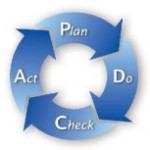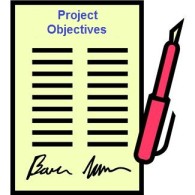Total Quality Management (TQM) for Projects
 The following checklist gives a common understanding of the TQM methodology, its approach and implementation steps. You can use it as additional guidelines for planning your project based on the methodology. We recommend using other TQM resources to learn the implementation process in detail.
The following checklist gives a common understanding of the TQM methodology, its approach and implementation steps. You can use it as additional guidelines for planning your project based on the methodology. We recommend using other TQM resources to learn the implementation process in detail.
Definition
Total Quality Management (TQM) is a popular customer-based methodology of quality control and improvement derived from Japanese industry since the 1950’s. It offers a unique approach for managing quality of a product or process while looking to customers as the major source of quality definition. In other words, TQM principles are based on customer requirements and standards to establish a continuous and dynamic process for product improvement. The methodology lets create an effective working environment where every person strives to consistently improve the product or process.
Because TQM is a customer-oriented methodology it requires every project team member to be completely involved in the improvement process. Every employee should focus on improvements while trying to enhance their personal productivity.
Improvement Sequence
 The improvement method of Total Quality Management requires using an iterative four-step management process for planning and monitoring quality of a product/service. This process is known as PDCA (Plan–Do–Check–Act). It creates an improvement sequence to be used within the methodology.
The improvement method of Total Quality Management requires using an iterative four-step management process for planning and monitoring quality of a product/service. This process is known as PDCA (Plan–Do–Check–Act). It creates an improvement sequence to be used within the methodology.
- Plan. First you must determine the problem, then identify possible reasons for that problem, and finally evaluate possible alternative problems and their reasons thought cause/effect analysis. Output: you develop a plan describing your problem, reasons, effect, and course of action for addressing the problem.
- Do. Now you need to implement your plan. You must involve a team in the implementation and start the improvement process.
- Check. During and after the implementation you must gather information on the observed effects of the problem. Your goal here is to find out what improvement solutions were successful.
- Action. At the final step you need to ensure that the improvement process has been implemented so the problem is successfully solved and the product quality is improved.
In combination with TQM principles, the PDCA improvement sequence significantly increases the likelihood of quality improvement success because it allows avoiding common management mistakes. The project manager gets a set of tools for planning, monitoring and solving potential issues.
TQM Implementation Steps
The method of Total Quality Management in combination with project management ideas can be carried out in 10 basic steps, which are listed below.
- Define the problem. First, you must define the problem to be addressed by your TQM-driven project. Cause-effect analysis and statistical data can be used for problem definition.
- Develop new strategic thinking. Your project team can use brainstorming and brain-writing as effective tools for developing solutions to the defined problem.
- Know the customer. TQM focuses on customers and their expectations so you must research needs and requirements of your customers. Conducting a customer survey, gathering data, and determining who your customers are will be the primary goals at this step.
- Determine quality requirements. Results of your customer survey will give you a description of customer needs and expectations. This information will be helpful for you to determine quality standards and requirements for your new TQM-based project.
- Plan for contingency. As you have a list of quality requirements based on your customers’ needs now you need to think about potential threats and uncertainties that surround your project and may negatively affect quality levels. You must plan for contingency and develop a risk response strategy to managing risks and eliminating their negative effect.
- Reduce waste. The TQM methodology requires you to run the project with minimized waste of resources. If you meet this requirement you reduce sources of waste and improve quality of your product/process in a cost-effective way.
- Develop a continuous improvement strategy. There should a strategy that ensures a continuous improvement process with multiple iterations and “buffers” (safety margins). You need to develop such a strategy or otherwise there’s no sense to start the TQM-based project because there’s n solid framework for managing and maintaining the improvement process continuously.
- Reduce variations. Total Quality Management offers a set of tools to reduce variations in quality of your product. You can use these tools to optimize use of project resources and minimize the likelihood of quality deficiencies and variations.
- Balance the approach. Your goal here is to make sure that the implementation process runs smoothly so there’s no lack of resources for every task or procedure of the process. You can reach this goal through continuous monitoring and tracking of your project.
- Apply the improvement process. The final step of TQM implementation is to use the improvement process in every facet of your project to start improving quality of your product.














